|
|
|
|
News The Project Technology RoboSpatium Contribute Subject index Download Responses Games Gadgets Contact <<< Magnets in magnetic fields Hysteresis loop >>> Magnetic hysteresisMicroscopic magnets (spins)Ferromagnetic materials are characterized by the magnetic moment of their particles (atoms, molecules). Those particles are often called microscopic magnets or spins. If those microscopic magnets are arranged in parallel, the resulting field is an addition of their single fields. Arranged in antiparallel mode, the fields are canceled out, like discussed at the chapter Magnets inside magnetic fields. The spins of ferromagnetic materials interact with themselves and with external magnetic fields. Those interaction leads to an arrangement of multiple spins inside ferromagnetic materials. You can observe the interaction with the help of the Java application Magnets at the previous chapter.Ferromagnetic materials without an external magnetic fieldA well known ferromagnetic material is iron. If you play around with a piece of iron (nail, paper-clip) you will notice, that those iron doesn't attract other pieces of iron. Even though iron consists out of many small magnets, it doesn't create an external magnetic field. The reason for this is the fact that all spins are arranged randomly and their fields are canceled out. As you can see at the Java app, not all of the magnets are arranged randomly, but there are some groups or chains of magnets pointing into the same direction. One of those group is opposed by other groups whose spin point in other directions and therefore the magnetic fields are canceled out. An area of spins pointing into the same direction is called magnetic domain or Weiss domain (named after the French physicist Pierre-Ernest Weiss).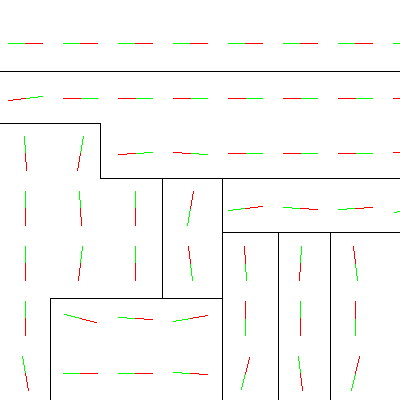
Detail of the Java application magnets. The areas with spins pointing into the same direction (Weiss domains) are plotted. Eye catching is the fact, that nearly all magnets are arranged in horizontal or vertical position. That is because of the fact that the magnets are arranged on a square grid. The tips of the magnet needles are closest to each other while pointing into horizontal or vertical direction. A small gap between the tips means strong interaction which leads to the observed pattern. With the help of the Java app you can arrange the magnets at the corners of equilateral triangles leading to different preferred angles (did you try?). Most of the solid matter around us is arranged in grids, too. Here you can also observe preferred orientations of the spins. Matter consists out of unique atoms (e. g. pure iron) or a mixture of different atoms (e. g. ferric oxide out of iron and oxygen). Accordant there is a manifold number of grids, the atoms and therefore the spins can be arranged in. It is still a fascinating field of research to find out the right kind of "element mixture" for a given utilization. Generating an external magnetic field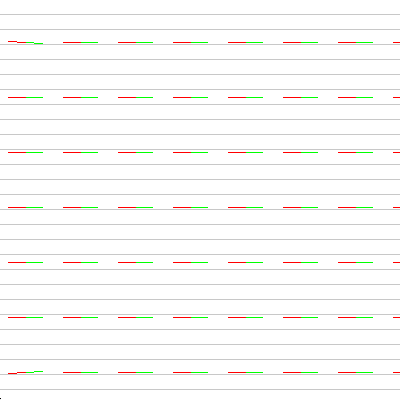
If a homogeneous magnetic field is induced around a ferromagnetic material, an additional torque is acting on the microscopic magnets, trying to turn them into the direction of the field lines of the external field. The field lines of the external field are painted with Grey lines at the picture on the left. The north pole of the external field is arranged at the right side of the picture. If you ran the Java program, you will have observed that not all of the magnets started turning around as soon as the external field was turned on. The movement takes place group-wise. The vertically oriented magnets start turning around at lower field strength, while the antiparallel (horizontal) oriented magnets start tilting at higher field strength. The simultaneous tilting of a whole domain or at least a group of spins is called Barkhausen effect (named after the German physicist Heinrich Barkhausen). The magnetization is changing in discontinuous, small jumps, which can be observed during measurements. If the material is exposed to a certain field strength, all spins will be arranged in parallel to the external field. This state is called magnetic saturation. Turning off the external field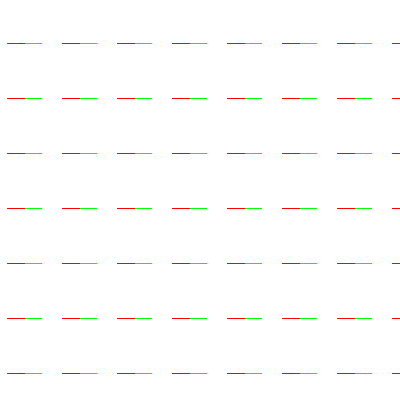
If the external magnetic field is turned off, the microscopic magnets just interact with their own magnetic fields. The grid, the magnets are arranged on and the angle of the external field are evident for the things occurring now. At the left picture you can see that the microscopic magnets remain in their positions after turning off the external magnetic field. The field lines were arranged in parallel to the grid points, meaning the gaps between the tips of the magnetic needles are as small as possible. According to the direction of the field, the south poles point to the right and the north poles to the left. The north pole of one magnets points to the south pole of the next magnet. The different poles are attracting each other and so they are arranged in a stable state of equilibrium. Energy was needed to turn one of the magnets around and so all of them stay in their position. The single magnetic fields of all spins are added up, leading to a measurable macroscopic field. If you put one pole of a permanent magnet to the tip of a iron nail and remove it slowly, you will notice, that the nail starts to attract other iron nails. This is because of the fact that some of the microscopic magnets remain in the position of the permanent magnet's field. The strength of the magnetization of the nail depends on the iron alloy used and on the strength of the permanent magnet. The nail won't remain in the state of magnetic saturation as can be seen at the left picture. The iron atoms of the whole nail are not arranged in a single grid. It consists out of many grains, whose grids are arranged in different directions. Therefore the magnetic field lines of the permanent magnet are not in parallel to all grains. What is happening to the spins of non parallel grains will be discussed now: External magnetic field not in parallel to the grid axis
The external field is arranged in an angle of 48 degrees according to the quadratic grid of the magnets. The magnets (especially at the boundary areas) are not completely in parallel to the field lines of the external field despite the full strength adjusted. 
After turning off the external magnetic field, the magnets start arranging themselves in parallel and vertical directions. The strength of the magnetization outside of the crystal lattice is lower than at the first case, because not all of the magnets are arranged in parallel to each other. Therefore an iron nail will never remain completely magnetized after turning off the external field. Antipodal magnetic field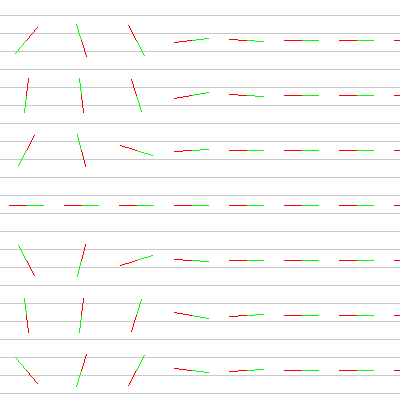
By now, a magnetic field with field lines running in the opposite direction is generated. The magnetic north pole is located at the left side of the picture. A certain field strength is needed to make the first magnets starting to turn around. If one magnet needle starts turning, their neighbor magnets start turning, too. Therewith groups of magnets start pointing to the direction of the external field. In between a state is reached where at all magnets cancel out their magnetic fields. If we turn off the external magnetic field right now, this piece of iron would be without magnetization outside the crystal lattice. 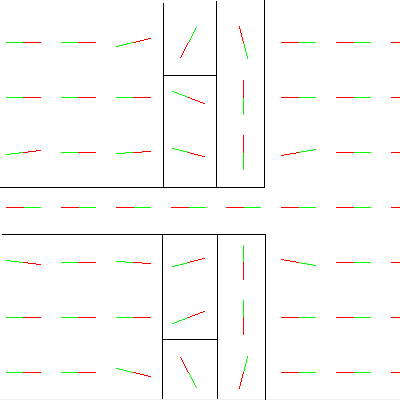
The extern magnetic field has been switched off and there is (almost) no magnetization recognizable outside the crystal lattice. Like at the beginning of the experiment, there are domains with spins pointing in different directions, canceling out any extern magnetic field. 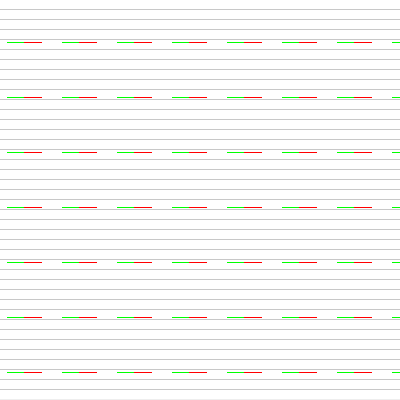
If the external magnetic field is turned on again and it's strength increases, all magnets will be arranged in parallel to the field (which was turned around for 180 degrees) sometime. Extremely persistent are the magnets of the middle row. Because of the fact that there are as many magnets below as well as above those line, the disturbances acting on the middle line are canceled out. A higher field strength has to be adjusted to make the middle line of magnets turn around, too. The higher field strength is also needed to make the magnets turn around once more (with the north poles to the left)! The field strength needed to reach the magnetic saturation depends on the "previous history" of a ferromagnetic material. Switching off an external magnetic field doesn't turn a piece of iron into it's initial state - a field pointing into the opposite direction is needed to erase the magnetization! This kind of behavior is called magnetic hysteresis <<< Magnets in magnetic fields Hysteresis loop >>> News The Project Technology RoboSpatium Contribute Subject index Archives Download Responses Games Links Gadgets Contact Imprint |
|
|